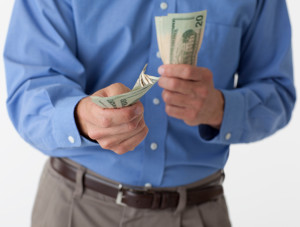You know those infomercials that offer you a “value” for only .95? Who are they to tell you what the value is? How do sellers decide what to charge? They usually decide on that value in one of four ways:
- Cost-plus
- Me-too
- Wishful thinking
- Value-based pricing
The first two methods have the advantage of being reasonably easy to calculate, and are grounded in objective reality; the third method is not worth commenting on but all too common.
Value-based pricing is usually a major improvement over the first three “inside-out” approaches, because it forces the seller to think from the outside-in, and look at pricing from the customer’s point of view. Depending on what’s being sold, it can provide an excellent way to break out of the commodity trap and realize a premium for their product.
But when we get into the world of complex B2B sales, there are two serious flaws with VBP. First, it can be enormously difficult to precisely calculate the value a product brings to customers in general and even more so for specific individual situations. It requires a lot of knowledge of their business, their markets and their processes. Customers themselves, who know more about their own businesses than the salesperson ever will, often don’t know what something is worth to them until they buy it and apply it, and even then the question usually remains unasked and unanswered. What’s the value of a glass of cold water? It depends on whether you’re in a restaurant or on a desert island.
Second, VBP is not always realistic. There is a very loose connection between perceived value and the actual price someone will pay for something.
In B2B selling, VBP generally is better than cost-plus and me-too pricing, but it’s still not the complete answer to the question of what something should or could be sold for. There is another way, called Willingness to Pay (WTP). It combines the realism of cost-plus and me-too with the customer focus of value. It’s real because it’s proven in daily experiments called transactions. You can conduct focus groups or talk to customers all day long to find out what they value, and none of that information will amount to a hill of beans until you test it by having people put their money where their mouth is. Ask them to make a decision. The decision is simple: will they buy your product for the offered price?
WTP is customer focused because it resides solely in the mind of the customer. It is personal, situational, and psychological, which is the world that salespeople live in. As we’ve seen earlier, even a $20 bill can have a wide range of different values, depending on the customer’s situation or state of mind.
Value will tell you what something is worth, but not what someone will pay to get it. Buyers care less about what something is worth than about how little they can part with to get it. Sellers care less about what something is worth than about how much they can get for it.
Value is theory, but WTP is reality. The key word is pay. Pay implies an actual decision that carries consequences. The decision costs real dollars and may be subject to questioning by others. I may think something is “priceless” or extremely valuable to me, but would often balk at paying what something is worth to me. Someone may write a book whose advice can literally change your life and make you tons of money, but you would never pay thousands of dollars for it.
If you ask people what something is worth to them, their answers are essentially meaningless, because they may not know exactly how they feel about something until they have to make a decision—to put their money where their mouth is. It’s measured every day in the decisions that buyers make, the purchases they close or the deals they walk away from.
The greatest drawback of WTP is that it can be complicated and difficult to figure out for each individual buyer, because there are so many factors that can bend the number up or down. But that complexity also furnishes the best opportunity for a prepared, informed and ingenious seller to find myriad ways to structure an offer that provides the best win-win outcome for both parties. In the next article of this series, we will dissect that complexity and examine the anatomy of willingness to pay.
 The key premise of consultative or insight selling is that the salesperson can bring new ideas to clients to show them how to improve their business. Put another way, they can bring solutions to problems the clients don’t yet know they have.
The key premise of consultative or insight selling is that the salesperson can bring new ideas to clients to show them how to improve their business. Put another way, they can bring solutions to problems the clients don’t yet know they have.
But what gives you the right to do that? What gives you the right to approach someone who has been wrestling with a problem for a long time, and claim that you know something they don’t? What makes you so smart?
It’s a good question, and you know that your clients and prospects will be asking it.
To paraphrase Will Rogers, “Everyone is smart, only on different subjects.”[1] Your perspective is what makes you smart enough to bring insights and tell clients what is good for them. You have three perspective advantages your clients don’t have:
Deeper: The product or service you are selling, and the problems you deal with are your bread and butter; they are well known to you. Unless it’s a recurring purchase, your client may be facing the decision for the first time. Your specialized knowledge makes you smarter than them—at that particular topic.
Wider: Your clients may each individually know a lot about their own industries or geographies, but you—and your company—have a wide variety of clients in different industries and different geographies. Even if you’re facing a novel situation, you have access to a network within your own company and client circles that may have special experience or insight into the problem or opportunity.
Longer: If you’ve been in your position long enough, you’ve likely developed the expert ability to recognize patterns in situations that gives you an intuitive feel for the right way to proceed in solving a problem.
It all adds up to the special advantage of tacit knowledge: There is a widespread misconception that all you need to know is available through search engines, so it’s easy to get intimidated when experts tell you that your prospects have already completed X% of the evaluation process before you get involved in the purchase. But the three advantages of depth, width and length that you have, give you far more knowledge than can be articulated or put into a database. Who is to say that one piece of information might not make the crucial difference between success and failure in the purchase decision? Sometimes, you don’t even know what you know—until the situation challenges you to get creative.
In summary, there are many ways to be “smarter” than your clients in the areas that matter to them. But of course none of these will help you if you are not continuously learning, staying on top of what’s going on in your industry, connecting with other like-minded people—in short, continuously adding to your store of professional expertise.
I recently wrote a post in which I said some unkind things about salespeople who immediately wave the white flag of surrender when they’re confronted with price resistance. In fairness, it’s one thing to criticize, and quite another to offer solutions. This article is a start.
If the first battle you have to win is the one in your own mind, the key to winning the price war is to go into it with the right mindset. Here are some modes of thinking that you may need to change:
From price to cost: In complex systems sales, price is often a small part of the total cost of using the product or service. That’s why initial price savings may end up being very costly over the life of the purchase. As a cabdriver in Vegas once told me: “I’m too poor to buy cheap shoes.”
From cost to investment: Cost implies loss, investment implies a return. Focus on what the buyer will get out of the decision, not what they have to put in. If you see a promising investment, you don’t try to minimize how much you put in; you always want to put in more money.
From saving money to making money: If anyone was in business to save money, they could just shut their doors. Saving is only a means to an end, and it’s not always the best way to get there.
From wants to needs: Everyone wants a low price, but they usually need something more important. Your job is to know their situation so well that you can guide and teach them about needs they may not even be aware of.
From product to solution: People don’t buy products, they buy solutions to problems, some of which they don’t yet know they have. Focus on the problem and the price will recede in significance.
From pie slicing to pie growing: A lot of the mental energy that’s wasted in arguing over who gets the bigger slice of the pie may be better expended in jointly working on ways to generate more cash flow through imaginative ways of using the solution to improve their operations.
From defending your higher price to making the competitor defend their lower price: In a free enterprise system, sellers charge what the market will bear. If their price is lower, they must know something about their offer; make sure you and the buyer are asking the right questions.
There is a lot of discussion among sales experts about value-based pricing. It’s supposed to be better than more traditional methods such as cost-plus and me-too pricing. And it is, but it’s still not the complete answer to the question of what something should or could be sold for. To understand why, let’s start with a really stupid question:
What’s the value of a bill?
This isn’t a trick question; the answer is clearly .
Now, let’s ask a different question: how much could you sell a $20 bill for?
Value is what something is worth, but the real number salespeople care about is what someone will actually pay for it, and the two numbers don’t have to match. In fact, they can be way different.
Let’s run a little thought experiment. Suppose you went out to try to sell the $20 bill. How much could you get for it? Imagine that you went out to the local mall or wherever people hang out and walked up to complete strangers and asked them how much they would give you for it.
I haven’t tried this myself, but I would bet that no one would pay you what it’s worth. Why should they? They are no better off, so why go to the effort or take the risk to make the exchange? At best, most people would offer you $19 (let’s keep it simple and assume there’s no change). It’s the highest price they would be willing to pay and still be better off.
But I would guess that you would find very few takers even at $19, at least not without some serious sales efforts. You would have to answer a lot of questions to allay the buyer’s suspicions. How do they know the bill is real? How do they know you will actually hand it over when they’ve paid? What’s wrong with it? Where has it been?
Let’s run a few more scenarios:
Do you think it might make a difference if you were wearing a suit and tie as opposed to a ragged t-shirt and shorts?
What if you had 20 ones instead of a $20 bill, and someone came up and said, “I’m baby-sitting 15 kids, and I promised I would buy them sodas, but the only place I can buy sodas is at this machine, which only takes dollar bills.” He may not be happy about it, but I bet he would sell you his twenty for fifteen ones.
The next guy comes up and has a different need. “My boss gave me a bunch of fives and told me I have to find a crisp twenty dollar bill for a promotion he’s running, and I need it right away.” He may not be happy about it, but I bet you could get him to fork over $25 for your twenty.
Maybe you have those new colorful counterfeit-protection twenties, and no one has seen them yet.
One guy listens to your pitch and says he would love to help you, but all he has on him is fifteen bucks.
Another person comes up and tells everyone gathered around: “There’s a kook at the other end of the mall who can’t stand the sight of Andrew Jackson, and he’s willing to trade his twenties for one Hamilton or two Lincolns.”
Or another vendor sets up shop ten yards away and tells all comers he will beat your prices by a dollar. How much could you get for your twenties then?
You’ve been given a stack of twenties and told you must sell them all before closing time as a condition of employment. It’s ten minutes to closing time, and you still have a few left, with just one or two people walking by. And one of them is the nice guy who only had fifteen bucks on him.
On the other hand, do you think it’s possible to sell the $20 bill for more than $20? Actually, it’s not that difficult, and I can say this because I have done it in real life—many times in fact—just to prove a point. The highest price I’ve received is $51 for a $20 bill. (It involves a special type of auction, which you can find in some negotiations books, but I won’t divulge it here for obvious reasons. The first five callers get the secret for free.)
So What?
While these scenarios might be a bit contrived, any salesperson can recognize credible analogies in their daily sales efforts. And that’s for a product that has an exact, measurable “value”, which almost never is the case in real-life sales.
The point is that value may be a precise number, but willingness to pay is personal, situational, and psychological. That’s the world that salespeople live in, and that’s why value is an inadequate guide to determining what something can be sold for. In our next article, we will examine the anatomy of willingness to pay.





